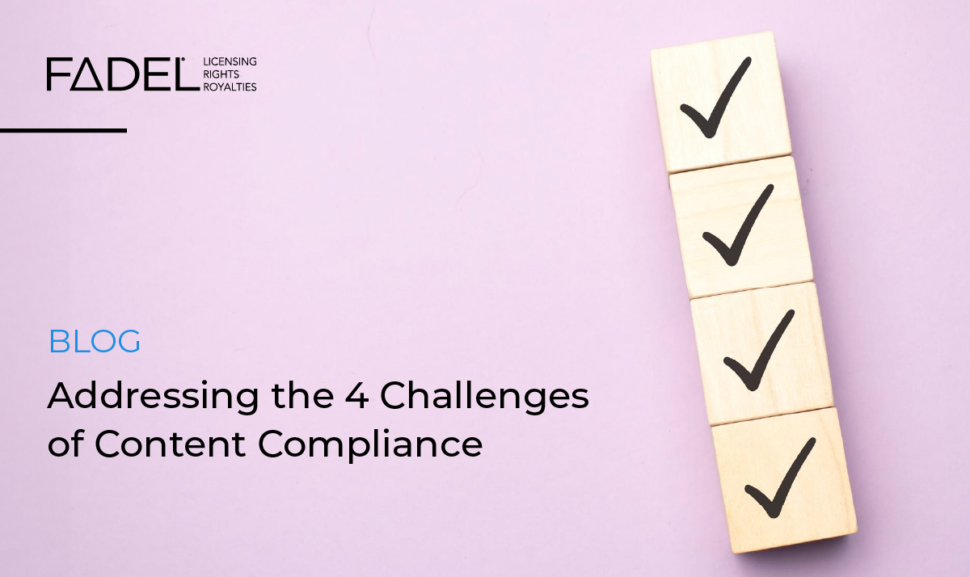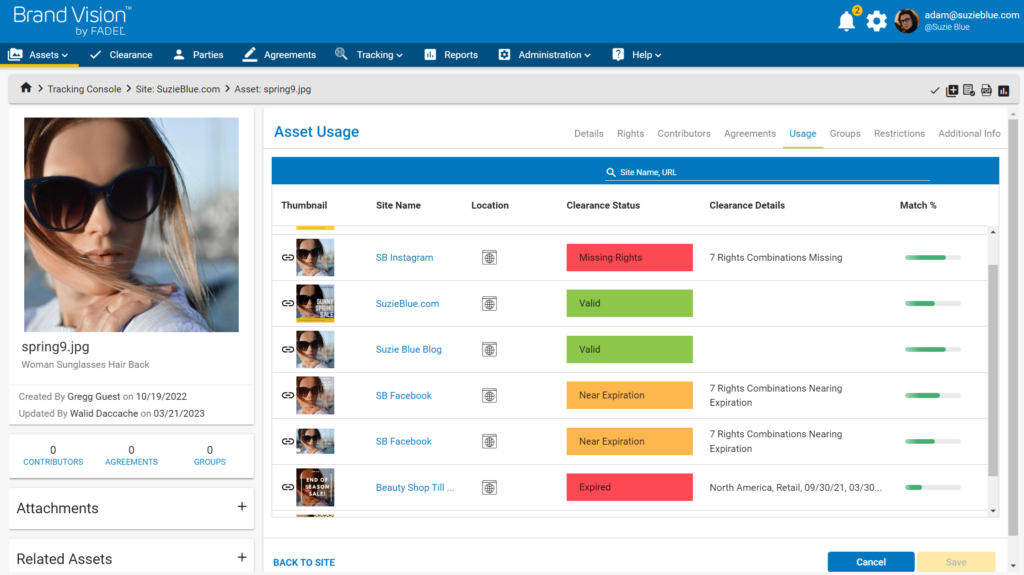
Addressing the 4 Challenges of Content Compliance
Do you know where your brand assets have been published? How do you keep track of them post distribution? Typically, content is published across multiple websites and social media feeds and touched by multiple roles over the course of the content lifecycle, from pre-production to production to post-production. With each touch, companies lose a little bit more insight and control over where their assets are and how they’re being used.
Challenge 1: Multiple Stakeholders = Limited Visibility and Control

Each stakeholder has a responsibility to uphold their part in protecting the brand, yet without visibility into what other parties are doing—both internally and externally—keeping tabs on the brand becomes difficult. For example, the content creator on the front end is ultimately responsible for putting assets together that adhere to rights and restrictions and making sure those get delivered/published correctly. The brand manager is tasked with ensuring the brand is being represented consistently and favorably. Creative artists and agencies want to assure that the content that is published is compliant with rights and usage agreements so they are not putting clients at risk by misuse. The legal team shares their concerns and is responsible for mitigating the risk of having assets published in ways or places they shouldn’t be or being used beyond their licensed date.
Challenge 2: Multiple Digital Channels
 According to a 2017 study by Aberdeen Strategy & Research, 51% of companies used at least eight digital channels to interact with customers. Fast forward to 2023, and not only has that percentage grown, some companies are managing hundreds of different channels and sites across SEO, PPC, mobile, display ads, websites, social, directing marketing, and so forth, all of which they are publishing content to. Furthermore, content is being published in partner or retailer ecosystems, and as these broaden, they become even harder to monitor. The further removed the content is from your company, the less insight and control you have. Some of the assets may undergo changes or be manipulated after distribution, for example cropped, recolored, edited, or even combined with other assets, and some of those manipulations may not be allowed by the licensing contract. Tracking all of these assets plus their variations is like looking for a needle in a pile of needles. This makes it really difficult, if not impossible, to track digital assets manually.
According to a 2017 study by Aberdeen Strategy & Research, 51% of companies used at least eight digital channels to interact with customers. Fast forward to 2023, and not only has that percentage grown, some companies are managing hundreds of different channels and sites across SEO, PPC, mobile, display ads, websites, social, directing marketing, and so forth, all of which they are publishing content to. Furthermore, content is being published in partner or retailer ecosystems, and as these broaden, they become even harder to monitor. The further removed the content is from your company, the less insight and control you have. Some of the assets may undergo changes or be manipulated after distribution, for example cropped, recolored, edited, or even combined with other assets, and some of those manipulations may not be allowed by the licensing contract. Tracking all of these assets plus their variations is like looking for a needle in a pile of needles. This makes it really difficult, if not impossible, to track digital assets manually.
Challenge 3: Various Events Can Introduce Risk
In the course of doing business, companies routinely face events that require them to assess where, when, and how their assets are being used and possibly change them out, take them down, or update them. These include:
 Rebranding of corporate messaging and brand assets, e.g., logo, name, messaging.
Rebranding of corporate messaging and brand assets, e.g., logo, name, messaging.- Retiring outdated campaigns, e.g., those related to a one-time event or holiday so the brand doesn’t seem stale.
- Product recall or change in legislation that would require a campaign asset to be taken down.
- Expiring talent contracts, assets, or content.
- Brand ambassador strategy, e.g., a scandal or an opportunity to better promote an influencer who has experienced a recent win.
- Developing a channel strategy, e.g., see how the brand is appearing and assess whether the strategy is performing to achieve goals.
Challenge 4: More Sophisticated Technology
While a standard website can pretty easily be crawled by a crawler that looks through the pages to find images, they’re not up to the task of searching more complex content delivery platforms. E-commerce sites, for example—whether Amazon, Shopify, or even Target and Walmart, use sophisticated content delivery systems that a normal crawler can’t process. Another example is social media sites that require credentials to access, like Facebook, Instagram, and TikTok. These types of platforms call for software that is specifically built for content tracking—software that includes custom crawlers or APIs that can gain access to content that may be affecting your brand without your knowledge.
The Business Case for Content Tracking
Having digital assets loose on the internet without monitoring them can affect your brand in numerous ways that range in consequences from bad press to hefty fines. Keeping tabs on your digital content can help you:
- avoid talent litigation for misuse.
- enforce corporate governance policies.
- ensure partner compliance.
- retain brand consistency.
- keep campaigns and initiatives relevant.
Overcoming Digital Content Tracking Challenges
As digital content continues to proliferate and more and more digital channels emerge, tracking will only become trickier. Increasingly, organizations are looking for solutions that can help them protect their brands, which has led to the new and growing market of digital brand compliance. Software providers in this space specialize in solving today’s content solutions with an eye toward the future, which guarantees staggering growth in digital asset volume as well as the channels in which they’re used for companies of all sizes.
5 Things to Look for in Content Tracking Solutions
 Rights management that ties talent and rights information to photos and video assets. This includes details like territories, social channels, maximums, expiration, obligations, and fees. If the rights aren’t linked to the asset, then tracking and monitoring usage is not nearly as useful. Sure, you may be able to see how and where it is being used, but you don’t have insights into violations or expirations that you need to take immediate action if there is misuse.
Rights management that ties talent and rights information to photos and video assets. This includes details like territories, social channels, maximums, expiration, obligations, and fees. If the rights aren’t linked to the asset, then tracking and monitoring usage is not nearly as useful. Sure, you may be able to see how and where it is being used, but you don’t have insights into violations or expirations that you need to take immediate action if there is misuse.- Visual search that uses image matching to quickly identify and analyze assets and rights. Watermarking and pixel embedding can get diminished through transformations and resolutions, meaning your search may not turn up the asset, even if it is being used.
- Content tracking features to keep an eye on websites and social media feeds (Facebook, YouTube, Instagram, etc.) for published photos and videos. This is an automated crawler that goes out and visits various sites and channels at whatever frequency you set so you don’t have to look manually, page by page, app by app, to find your assets and match them to the assets in your DAM.
- Monitoring capabilities to track usage and violations in real time, based on missing rights or expiration dates. This loops back to the importance of having rights management capabilities so that violations can be remedied immediately and expiring assets can be taken down before they are in violation.
- Reporting to stay on top of content usage and identify potential risks or expirations. It helps to have the ability to easily forward proof of licensing in case questions arise.
For a product demonstration of how FADEL Brand Vision can help you protect your brand with sophisticated digital content monitoring and tracking, download our on-demand webinar, “Where’s Willow? How do you Track and Monitor Published Image and Video Assets?” or request a 1:1 demo.









